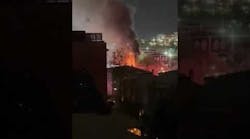ST. LOUIS, MO: May 1, 1909 — While burglarizing a home, Carroll Higgins was using a candle to illuminate his way. As he was taking silverware from a sideboard, his candle accidentally ignited heavy draperies around a doorway and the room was soon ablaze. The burglar quickly turned fireman, tearing down the drapes and extinguishing the flames. When he was satisfied the fire was out, he continued room to room and, despite the sleeping occupants, removed all the valuables he could find. Captured later, he stated he couldn't leave those asleep upstairs to be burned to death, but he was surprised they did not wake up to the smell of smoke.
BENEDICT, MD: May 4, 1909 — Flames that started in an oil stove in the store of A.M. Bowling spread throughout the building and began extending to other structures. Fire also destroyed the Methodist Church, Johnson's Stores, a hotel and every other building in the village except five houses on the river shore. The historic village, a popular vacationing spot for residents of Baltimore and Washington, is along the Patuxent River.
MANOR, PA: May 11, 1909 — A blaze that started in the drying room of the Beamer Handle Co. factory spread with lightning speed, almost trapping several workers on the floor above. As flames leaped from building to building, help was requested and hose companies from Irwin responded to the scene. A firefighting train from the Pennsylvania Railroad also rolled in and helped firemen make a stand against the building wall of fire. It appeared for a time as if the entire town and the nearby tanks of the Dexter Oil Co. were also to be lost. But determined firefighting, including the dangerous removal of explosives, paid off and the progress of the flames was finally halted. In all, seven structures and the original factory were destroyed.
PLYMOUTH, NH: May 12, 1909 — Sparks from a passing locomotive started a fire on the roof of the Pemigewassett House, a famous White Mountain inn. Flames spread to the Railway Express Office, railroad station and into the pine forest. As the 75 hotel guests fled, the town's hose wagon arrived and firemen worked in vain with a single hose stream until mutual aid from Ashland arrived.
AKRON, OH: May 18, 1909 — Flames tore through the seven-story Hower block, practically destroying the huge building. The structure was filled with various light-manufacturing concerns with nearly 200 employees at work at the time the fire was discovered. The blaze caused a panic among girls working above as smoke from the basement filled the structure. All employees were able escape without major injuries. Both the Goodyear and Diamond Tire companies had large stocks of rubber tires stored inside the building that were lost to the flames.
LYNN, MA: May 21, 1909 — An incendiary fire destroyed two four-story wooden buildings on Central Avenue. A policeman discovered the blaze on the top floor of a building and saw a man run from the scene. The fire quickly spread to the adjoining structure.
LONDON, ENGLAND: May 24, 1909 — Considerable commotion was caused as arcing wires and cables caused a smoky fire on a train of the London District Railway at Charing Cross. The fire occurred at the underground station and drove passengers to the street above. As this fire was controlled using sand, another fire was responded to in the Hotel Victoria on Northumberland Avenue. The hotel staff was trying to downplay the incident even as members of the London Fire Brigade stretched hoses into the building. The blaze was determined to be in an adjoining structure and was quickly extinguished, but not before a large high-pressure hose ruptured and soaked a number of hotel guests.
CENTRAL CITY, KY: May 25, 1909 — During commencement exercises at Mrs. D.C. Boyd's School, a candle held by a small girl ignited her dress and then set fire to the dresses of several other children as they crowded around her. A cool-headed man sprang from the audience and tackled the group of girls, smothering the flames with his coat. Several other men expanded these actions and all the flaming clothing was extinguished. Five children suffered possibly fatal burns despite these efforts.
PAUL HASHAGEN, a Firehouse® contributing editor, is a retired FDNY firefighter who was assigned to Rescue Company 1 in Manhattan. He is also an ex-chief of the Freeport, NY, Fire Department. Hashagen is the author of FDNY 1865-2000: Millennium Book, a history of the New York City Fire Department, and other fire service history books.





